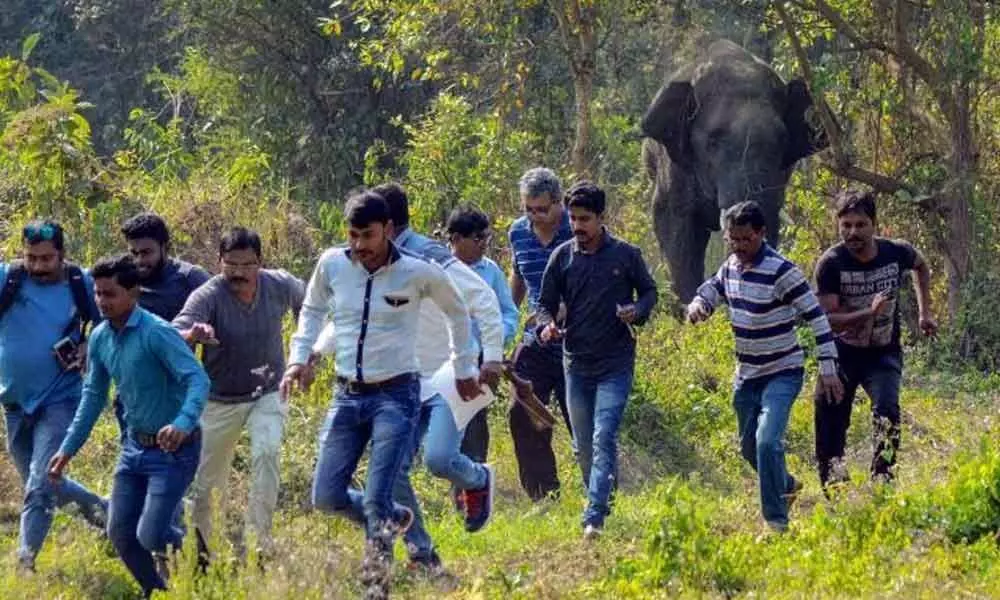Restore elephant habitats and corridors

World Elephants Day
Why do we need to preserve elephants and restore its habitats and corridors? It is directly linked to the survival of mankind. Forests are the best and cheapest carbon sink nature has provided.
Why do we need to preserve elephants and restore its habitats and corridors? It is directly linked to the survival of mankind. Forests are the best and cheapest carbon sink nature has provided. If elephants are there the habitats will remain intact and vice versa. Presence of elephant is an indication for the quality of the forests. We have seen nature's fury across the globe during last one month alone, when unprecedented heat waves, wildfire and severe flooding have wrecked havoc in the life of the people.
Owing to destruction of habitats and corridors, elephant herds stray in human areas for food, water and shelter. States like Assam, Chhattisgarh, Jharkhand, Karnataka, Kerala, Tamil Nadu, Odisha, West Bengal and Uttarakhand have been experiencing human-elephant conflict resulting in loss of lives and properties. Elephants also perish in retaliation, besides a number of them getting killed in train accidents. It can also electrocute itself by coming in contact with 11 KV sagging electric transmission lines unsettled by rains and winds.
Communities on the fringes of elephant reserves and corridors often lose patience and make enough noise to drive away the herds. A group of 14 wild elephants in China left its home range far south near the Laos border 16 months ago towards rich farm land bursting with corn, sugarcane, bananas and dragon-fruits in southeastern Yunnan province. As the herd traverses human areas the village is shooed indoors, its power supply is cut and finally banana and other elephant treats are dumped on opposite side of town to coax the uninvited guests to pass through. Nearly three dozen Yunnan forestry firefighters constitute a task force entrusted to track the herd and safely drive them home. Of course tracking night moving animals that can disappear in wooded areas and can also trek up to 30 kms a day is quite difficult task. The task force uses drones to keep tabs on the herd. When they approach a village, locals are urged through loudspeakers and door to door campaign to shut themselves in, preferably upstairs to remain out of reach of the visiting herd. Power supplies are cut to prevent elephants electrocuting themselves and sparking fire. The herd has not inflicted any human causality in past 16 months of straying out of its habitat so far.
Like China India has also anti-depredation squads driving the herds straying in human areas back to their habitats. The peripheries of the reserves are also provided with barriers using stone walls; elephant proof trenches, solar fencing and even rail barricades. Stone walls have generally been constructed along the rail tracks in Uttarakhand and West Bengal where elephant herds have been killed by fast moving trains. Precautions like watching the movement of elephants near the rail tracks, coordinating with railway department and slowing the speed of trains etc are regularly monitored, which has helped in bringing down such accidents.
Elephant proof trenches (EPT) are not very effective barrier as trench gets filled by the action of winds, rains and humans also cover it to make way to enter inside forests for collection of woods and grazing the livestock. Sometimes even elephants push earth and fill up the trench making the barrier ineffective. Solar fencing also requires regular maintenance. For nearly eight years now states like Karnataka have switched on rail barricading along the periphery of the reserves. Though it is quite expensive, but the proposition is viable as it is quite effective and there is no maintenance cost.
To prevent straying of elephants outside the habitats, Karnataka has erected 1700 km of solar fence and excavated 1000 km of EPT. Rail barricades being quite effective and is being constructed for last eight years; only 180 km of periphery has been covered with it. Cost of EPT is approximately Rs 20 lakh per km whereas the solar fence is Rs 5 lakh per km. As against this, the cost of per km rail barricade is Rs 125 lakh per km. Despite all the measures undertaken in Karnataka, on an average 30 human death takes place annually and further 15 elephants die due to unnatural causes and nearly 10 due to electrocution in a year.
Besides the barriers, anti depredation squads are engaged to drive straying elephants back in forests. Ex gratia payment is also made to victims' successors for loss of life of human, and damages to crops and livestock. The rate of ex gratia payment is revised periodically depending up on the market situation. Adequate compensation for the losses and its timely payment goes a long way in pacifying the public's outcry. I have consistently observed in my service that wherever officers are sensitive and take necessary steps, human wildlife conflict is minimized.
Scientists have conducted studies to pinpoint the reasons for depredation and status of habitats. Dr Prachi Mehta, Wildlife Research and Conservation Society has studied elephant anti depredation in Uttara Kannada district of Karnataka and trained farmers to protect their crops in community based conflict management model, which also include night guarding with early alert through trip alarm, laser sensors, use of chilly based deterrents to avoid elephant entry, farm based deterrents and use of bee-fences at locations where elephants enter the croplands. Dr Mehta has found in her studies that regularly guarded croplands are avoided by elephants and crop losses are minimized.
T N C Vidya,scientist from Indian Institute of Science, Bengaluru has studied changing behaviour of elephants in Nagarhole National Park over past two decades and has observed that there has been increasing pressure from land use changes, habitat degradation, noise and disturbances from road traffic causing elephant herds straying in human areas. We have unintentionally entered into an arms race with elephants in many areas. The more aggressive responses people show, the more elephants also retaliate, which becomes a vicious cycle and goes on endlessly. Areas covered by rail barricading have curtailed the home ranges of elephants, which are required to be studied further.
Growing areas under invasive species like Eupatorium and Lantana has resulted in decreasing grass cover. A negative correlation has been found between lantana density and elephant dung density in Mudumalai Sanctuary of Tamil Nadu (Wilson et al. 2013, Journal of Tropical Ecology). Elephants straying outside and causing human death are also captured and brought to captivity and permanently housed in Forest Department run elephant camps. Olden day's captive elephants were utilized for logging operations in remote undulating terrains but at present there is no such activity.
Elephants in private ownership are used by temples, marriage procession, begging and ferrying the tourists etc and are often ill treated by mahouts and owners. They are abused, not fed properly and also sometimes abandoned. An NGO named Wildlife SOS runs a rehabilitation centre in Mathura. Seized elephants from private ownership are brought here for lifetime care. Wildlife SOS has established one of the best hospital facilities in 2018 and takes care of 28 elephants there. More such facilities are needed across the country. Safeguarding elephants, restoring their habitats and corridors is important to maintain natural balance and mitigate climate change impacts.
(The author is Former Principal Chief Conservator of Forests (Head of Forest Force), Karnataka)



















